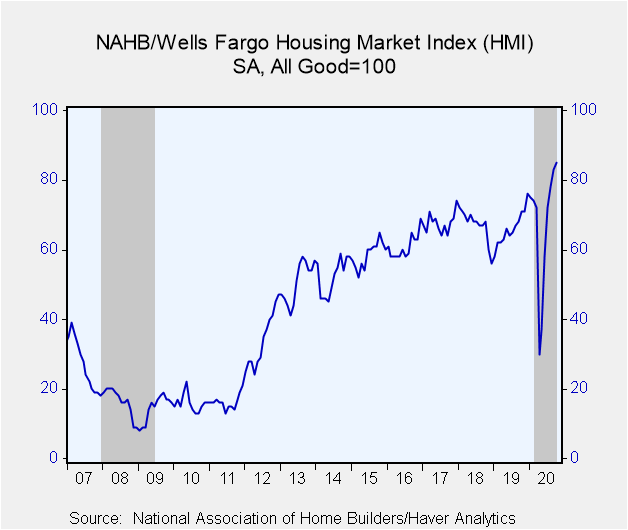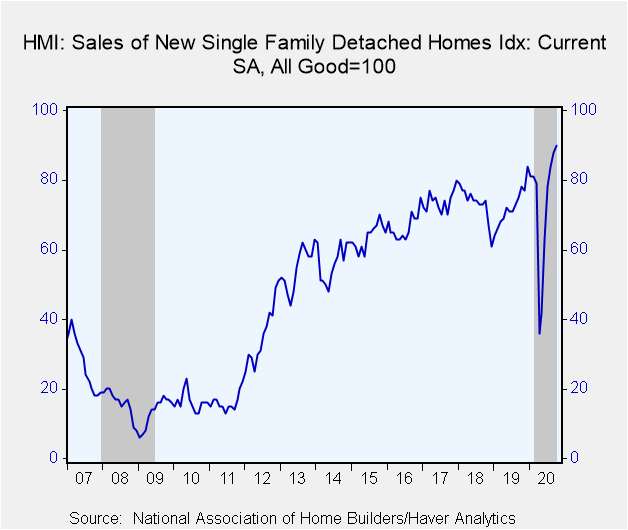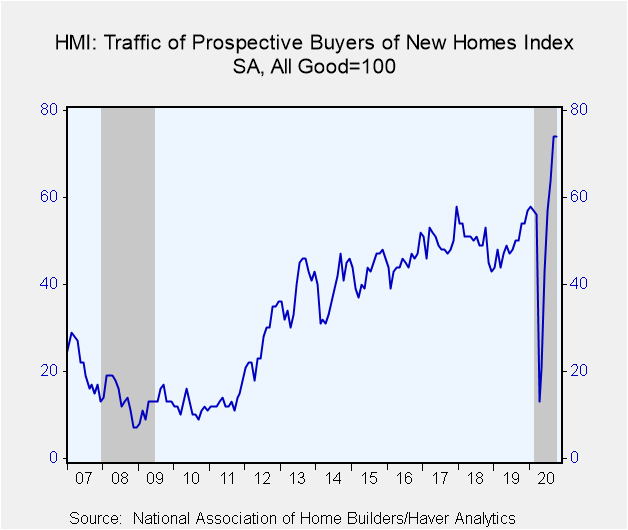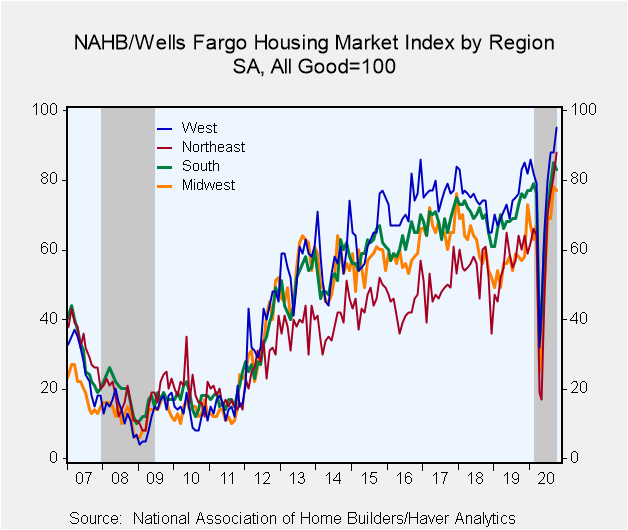 Global| Oct 19 2020
Global| Oct 19 2020U.S. Home Builder Sentiment Logs Another Record High
by:Tom Moeller
|in:Economy in Brief
Summary
• Housing market activity is exceptionally strong. • Number of prospective buyers improves to record level. • Monthly increases were mixed regionally. The Composite Housing Market Index from the National Association of Home Builders- [...]
• Housing market activity is exceptionally strong.
• Number of prospective buyers improves to record level.
• Monthly increases were mixed regionally.
The Composite Housing Market Index from the National Association of Home Builders-Wells Fargo increased 2.4% to a record 85 during October from 83 in September. The index has risen 19.7% during the last twelve months. The monthly gain outpaced expectations for m/m stability at 83 in the INFORMA Global Markets survey. The NAHB figures are seasonally adjusted. Over the past 15 years, there has been a 70% correlation between the y/y change in the home builders index and the y/y change in new plus existing home sales. The figures date back to January 1985.
The index of present sales conditions rose 2.3% to 90 in October, a new record high. The index level is 15.4% higher over the last twelve months. The index of expected conditions in the next six months increased 3.5% to a record 88 and is 15.8% higher y/y. The index measuring traffic of prospective buyers held m/m at 74 (37.0% y/y).
Regionally, last month's figures differed greatly across regions. The index for the Northeast strengthened 8.6% (46.7% y/y) to a record high of 88, up from the recession low of 17 in May. In the West, the index improved 8.0% (14.5% y/y), also a record. To the downside, the index for the South declined to 83, off 2.4% m/m but still improved 9.2% y/y. The index for the Midwest eased 1.3% to 77 from a September record. Nevertheless, it still increased three-fold versus the April low of 25. These regional readings date back only to December 2004.
The NAHB has compiled the Housing Market Index since 1985. It reflects survey questions which ask builders to rate sales and sales expectations as "good," "fair" or "poor" and traffic as "very high," "average" or "very low." The figures are diffusion indexes with values over 50 indicating a predominance of "good"/"very high" readings. In constructing the composite index, the weights assigned to the individual index components are: 0.5920 for single-family detached sales, present time, 0.1358 for single-family detached sales, next six months, and 0.2722 for traffic of prospective buyers. These data are included in Haver's SURVEYS database.
U.S. Economic Outlook, Monetary Policy, and Initiatives to Sustain the Flow of Credit to Households and Firms from Fed Vice Chair Richard H. Clarida is available here.
| National Association of Home Builders | Oct | Sep | Aug | Oct'19 | 2019 | 2018 | 2017 |
|---|---|---|---|---|---|---|---|
| Composite Housing Market Index, SA (All Good=100) | 85 | 83 | 78 | 71 | 66 | 67 | 68 |
| Single-Family Sales: Present | 90 | 88 | 84 | 78 | 72 | 73 | 74 |
| Single-Family Sales: Next Six Months | 88 | 85 | 78 | 76 | 72 | 74 | 76 |
| Traffic of Prospective Buyers | 74 | 74 | 64 | 54 | 49 | 50 | 50 |
Tom Moeller
AuthorMore in Author Profile »Prior to joining Haver Analytics in 2000, Mr. Moeller worked as the Economist at Chancellor Capital Management from 1985 to 1999. There, he developed comprehensive economic forecasts and interpreted economic data for equity and fixed income portfolio managers. Also at Chancellor, Mr. Moeller worked as an equity analyst and was responsible for researching and rating companies in the economically sensitive automobile and housing industries for investment in Chancellor’s equity portfolio. Prior to joining Chancellor, Mr. Moeller was an Economist at Citibank from 1979 to 1984. He also analyzed pricing behavior in the metals industry for the Council on Wage and Price Stability in Washington, D.C. In 1999, Mr. Moeller received the award for most accurate forecast from the Forecasters' Club of New York. From 1990 to 1992 he was President of the New York Association for Business Economists. Mr. Moeller earned an M.B.A. in Finance from Fordham University, where he graduated in 1987. He holds a Bachelor of Arts in Economics from George Washington University.










